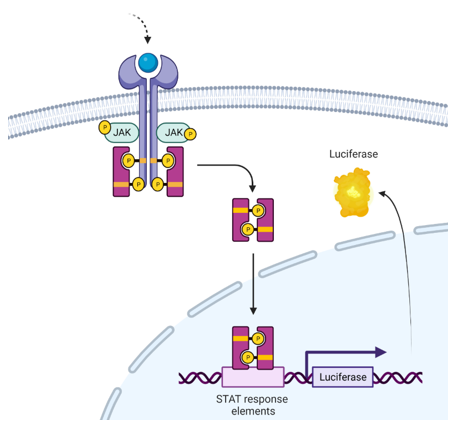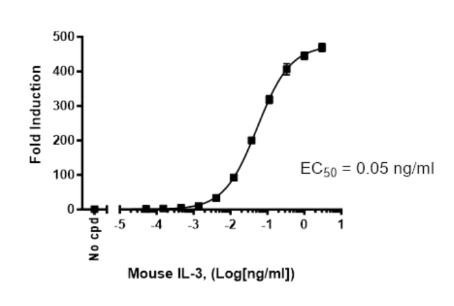STAT5 Luciferase Reporter Ba/F3 Cell Line
The STAT5 (Signal Transducer and Activator of Transcription 5) Luciferase Reporter murine Ba/F3 cell line monitors STAT5-mediated signal transduction pathways. It contains a firefly luciferase gene driven by STAT5 response elements located upstream of a minimal TATA promoter. After activation by relevant cytokines or growth factors, endogenous STAT5 binds to the response elements, inducing transcription of the luciferase reporter gene.
This cell line responds to mouse interleukin-3 (IL-3).

Figure 1: Illustration of STAT5 Luciferase Reporter Ba/F3 Cell Line.
Created with BioRender.com
Interested in screening and profiling inhibitors, blocking antibodies, or activators of STAT5-mediated signaling without the need to purchase and license the cell line? Check out our Cell Signaling Pathway Screening.
Purchase of this cell line is for research purposes only; commercial use requires a separate license. View the full terms and conditions.
Media Required for Cell Culture
| Name | Ordering Information |
| Thaw Medium 8 | BPS Bioscience #79652 |
| Mouse IL-3 | BPS Bioscience #90189 |
| Growth Medium 8A | BPS Bioscience #79653 |
Materials Required for Cellular Assay
| Name | Ordering Infromation |
| Assay Medium: Thaw Medium 8 | BPS Bioscience #79652 |
| Mouse IL-3 | BPS Bioscience #90189 |
| ONE-Step™ Luciferase Assay System | BPS Bioscience #60690 |
| White, clear-bottom 96-well tissue culture plate | Corning #3610 |
| Luminometer |
The cell line has been screened to confirm the absence of Mycoplasma species.
Signal transducer and activator of transcription 5 (STAT5) includes the highly related proteins STAT5A and STAT5B. These transcription factors relay cytokine-induced signals from the membrane to the nucleus, regulating the expression of hundreds of specific target genes. Cytokine or growth factor binding to its receptor activates a kinase of the JAK (Janus Kinase) family, which then phosphorylates STAT5 to trigger its dimerization and nuclear translocation. STAT5 is involved in the development and function of B and T cells. Constitutive phosphorylation of STAT5 is often observed in cancer. The use of inhibitors of the JAK/STAT pathways are potential candidates for the treatment of inflammation related diseases.
- Palacios R., et al., 1984 Nature, 309 (5964): 126-131.
- Jaster R., et al., 1999 Cell Signal., 11(5): 331-335.


